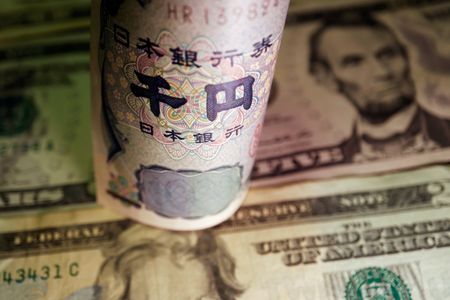By Rae Wee and Kevin Buckland
SINGAPORE (Reuters) -The yen slid to a nine-month low on Wednesday, prompting more jawboning from Japanese officials to stem the currency’s decline, while the dollar nursed losses after private-sector U.S. jobs data stoked worries about labour market weakness.
The yen bottomed at 154.79 per dollar in the Asian session, its weakest level since February, before retracing its losses slightly after comments from Japanese Finance Minister Satsuki Katayama.
Katayama said on Wednesday she would not deny that the negative aspects of the weak yen on the economy have become more pronounced than the positive ones.
“Markets and Katayama are both drawing a line at 155,” said Shoki Omori, chief desk strategist at Mizuho Securities.
“I would not be too surprised if dollar/yen surpasses 155 … triggering more verbal intervention from Katayama. However, the more Katayama shoots bullets at the market, the less reactive the market will be. The next step will be for the vice minister to step in and comment more often.”
The yen has fallen nearly 0.8% for the week thus far, bruised by the overall risk-on market sentiment on optimism over an imminent end to the U.S. government shutdown, and as investors expect greater fiscal largesse under new Prime Minister Sanae Takaichi.
Takaichi said on Wednesday she “strongly hopes” the central bank conducts monetary policy to stably achieve its 2% inflation target driven by wage increases, rather than rising raw material costs.
Earlier this week, she said she would work on setting a new fiscal target extending through several years to allow more flexible spending, essentially watering down the country’s commitment to fiscal consolidation.
Against the yen, the euro was similarly up more than 0.3% to a record high of 179.14, while sterling rose 0.26% to 203.11 yen.
WEAKENING LABOUR MARKET?
In the broader market, the dollar rose slightly as it recovered some of its losses from the previous session, helped in part by a weaker yen.
Overnight, payroll processor ADP said that U.S. firms shed more than 11,000 jobs a week through late October, underscoring how hiring trends are evolving and pointing to further weakening in a labour market being closely monitored by Federal Reserve policymakers.
That knocked the dollar lower, as traders ramped up bets of a Fed cut in December.
Sterling was last down 0.08% to $1.3138, while the euro was last steady at $1.1579.
Against a basket of currencies, the dollar rose 0.1% to 99.54.
“The alternative data, I think, overall points to a softer labour market picture … but whether we’re seeing a worsening deterioration in the U.S. labour market, I think that remains an open question,” said Sim Moh Siong, a currency strategist at Bank of Singapore.
“I think the broad set of data suggests that the labour market is cooling, but only gradually so, and I think we should see some confirmation of that from the return of official data likely by next week, with the reopening of the U.S. government.”
Traders are currently pricing in a roughly 64% chance that the Fed would ease rates by 25 basis points next month, though are awaiting an imminent reopening of the U.S. government for further clues as a backlog of economic data is set to be released.
The Republican-controlled House of Representatives is due to vote on Wednesday afternoon on a compromise that would restore funding to government agencies and end a shutdown that started on October 1.
“We remain of the view that the balance of risks to the labour market, inflation and consumption favour a 25-bp rate cut next month,” said Brian Martin, ANZ’s head of G3 economics, in a note.
In other currencies, the Aussie rose 0.12% to $0.6536, while the New Zealand dollar was little changed at $0.5655.
A top Australian central banker said on Wednesday that there was increasing debate about whether the current cash rate of 3.6% is restrictive enough to keep inflation in check, adding that the question is critical for the policy outlook.
(Reporting by Rae Wee; Editing by Shri Navaratnam and Christopher Cushing)











